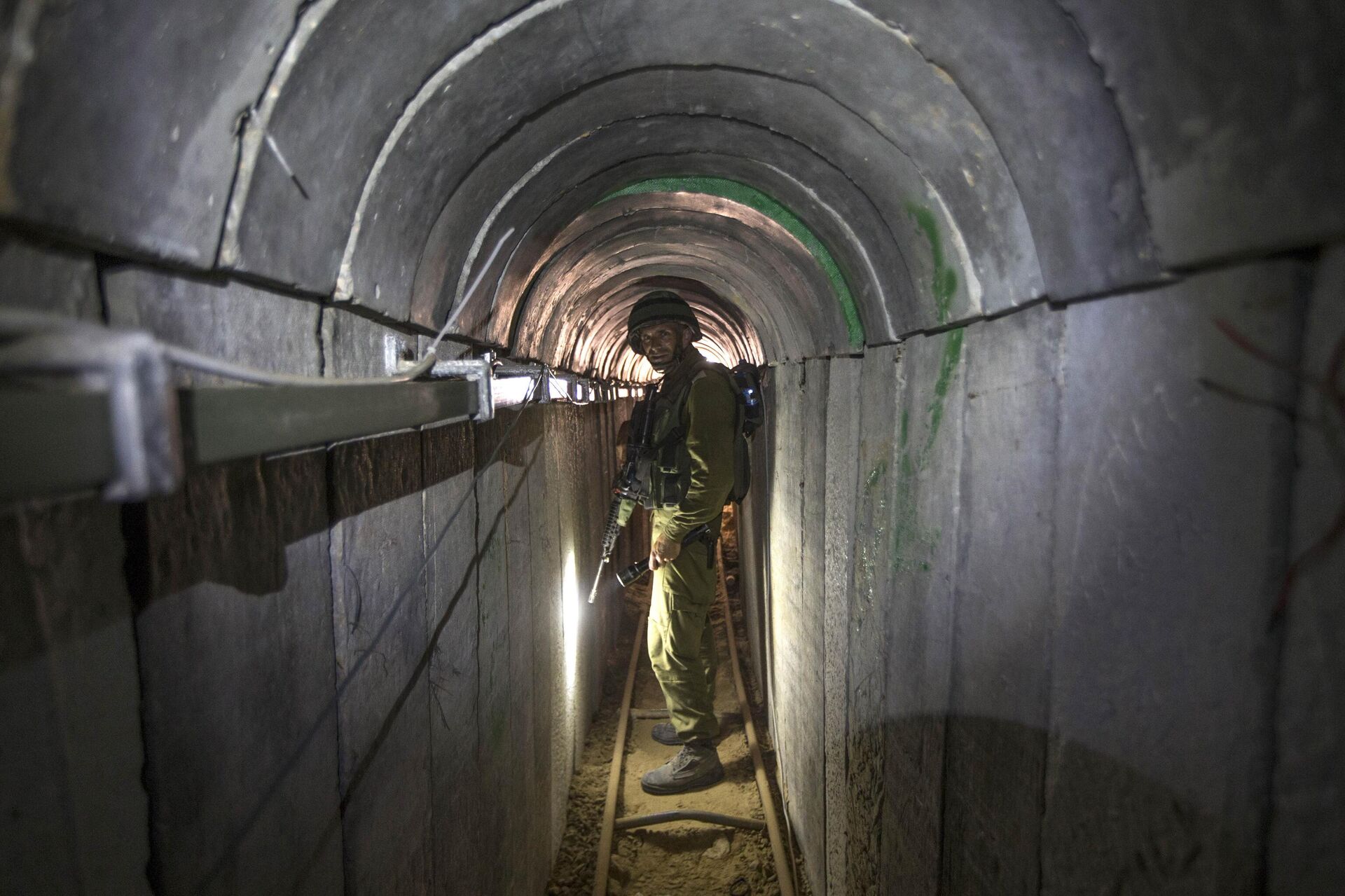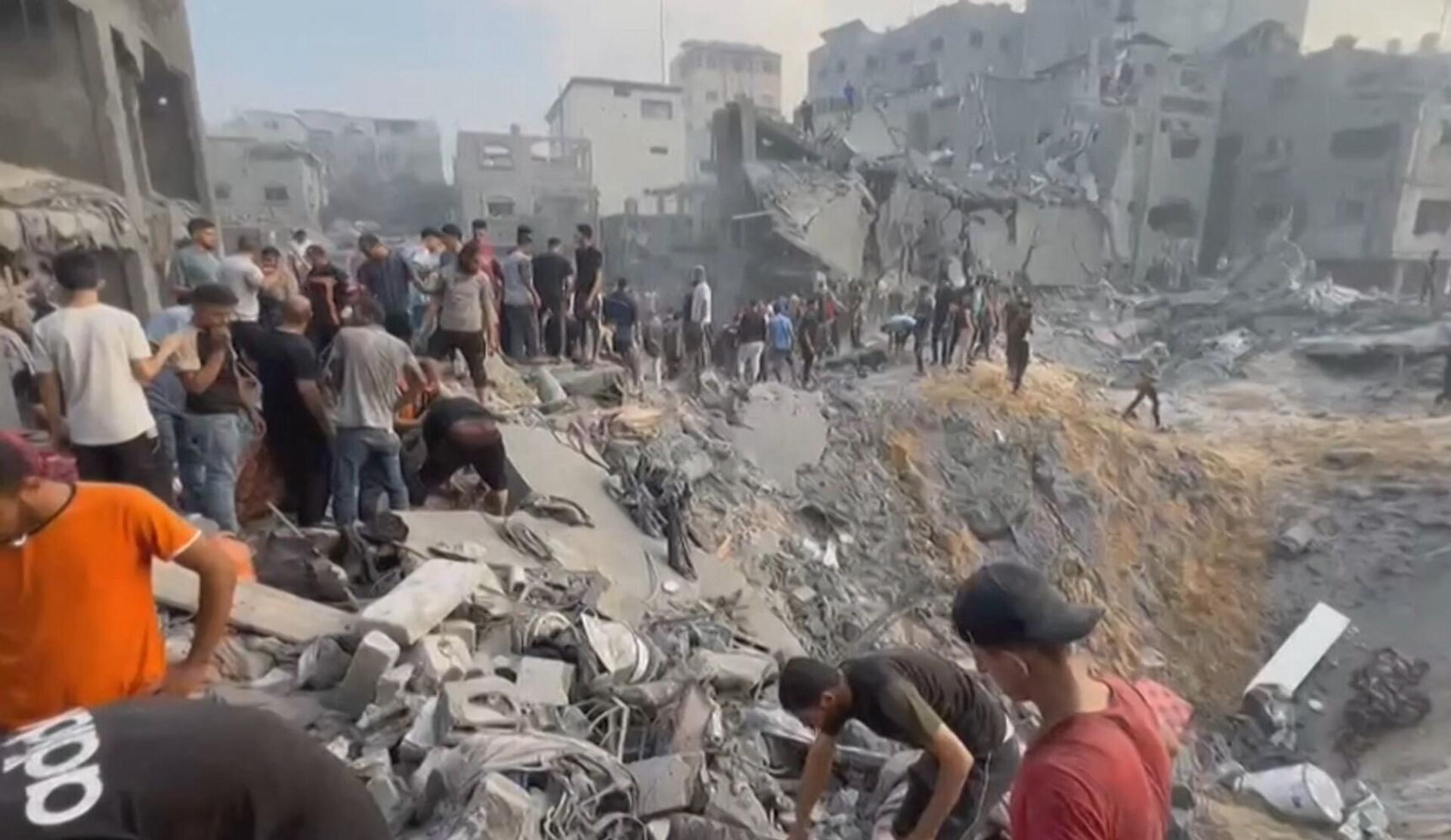Operation Labyrinth: Israeli Military Strategy & Obstacle of Hamas Underground Fortress
11:20 06.11.2023 (Updated: 18:16 10.11.2023)

© AP Photo / Ariel Schalit
Subscribe
Recently, Israeli Prime Minister Benjamin Netanyahu announced the commencement of the second stage of IDF’s ongoing war against the militant group Hamas.
By Aaryaman Nijhawan*
As part of this new phase, Israeli forces are “expanding their ground operations” within Gaza, combined with one of the most intensive aerial bombardments the small patch of Palestinian territory has seen. Israeli authorities are avoiding calling it an invasion. However, mere semantics won’t defeat the harsh ground realities that the Israeli troops will face.
As part of this new phase, Israeli forces are “expanding their ground operations” within Gaza, combined with one of the most intensive aerial bombardments the small patch of Palestinian territory has seen. Israeli authorities are avoiding calling it an invasion. However, mere semantics won’t defeat the harsh ground realities that the Israeli troops will face.
First of all, Israeli soldiers are entering a hostile arena alien to them. Their enemy, Hamas, has a clear tactical advantage because they are fighting on their home ground. Even if the airstrikes might’ve reduced entire neighborhoods into ruins, Hamas fighters will be exponentially better able to navigate the ruins of their homes than Israeli fighters dependent on navigational maps and drones. All military experts are aware that an attacker force naturally faces a disadvantage in terms of terrain navigation when it’s on alien territory, despite Israeli soldiers being stationed there in the past.
Secondly, combine this with the fact that the Israeli forces are venturing into an urban battleground with possible close-quarters combat. Urban warfare is something no army desires – it is costly, complex, involves close-quarters combat, and almost nullifies the numerical superiority of the attacking force. In short, it’s a nightmare for the attacker. A city of gigantic proportion with even a small but determined defending force would make hell on earth for the attackers.
Thirdly, on top of that is the biggest challenge to the IDF: the extensive labyrinth of underground tunnels, shafts, and passageways that Hamas has built over the years. Some even equate it to a ‘city within a city’, full of booby traps, ambush points, motor-assembly works, and ordnance stores for Hamas fighters. These vast, fortified tunnel complexes sometimes extend as far as 500 kilometers and are wide enough at places for small vehicles to travel through. The militant group knows these tunnels like the back of its hand; for any Israeli soldier, it is his or her worst nightmare. To offset this advantage Israeli forces have allegedly used American bunker-busting munitions to try to collapse these tunnels – the intensification of aerial bombardment might’ve been just those being dropped.

FILE - In this Friday, July 25, 2014 file photo, an Israeli army officer gives journalists a tour of a tunnel allegedly used by Palestinian militants for cross-border attacks, at the Israel-Gaza Border.
© AP Photo / Jack Guez
However, critics are skeptical whether these munitions are effective against the tunnels under Gaza as some testify that they run deeper than the penetrating power of Israeli bombs. Even if Israeli forces did manage to destroy some of the tunnels, there is little chance they’ll be able to destroy this underground city – Israeli soldiers will have to venture into these deadly ‘deathtraps’ if only to rescue the hostages believed to be held within them by Hamas. However, success in this field is highly doubtful, as highlighted by a 2017 RAND Corporation report that analyzed Tel Aviv’s past operations against Hamas in 2008 and 2014. The report noted with concern that Israeli forces struggled to detect and destroy the increasingly complex tunnel network laid by Hamas.
Complicating this is the ill-preparedness of the Israeli ground troops in mounting an offensive of this scale and complexity. It is important to note that most of the Israeli soldiers have undergone only basic military training totaling mere weeks and for the most part had been consigned to being guardsmen for the Israeli settlements established in Palestinian territories. Furthermore, this army was bolstered with 300,000 reservists on Netanyahu’s orders after the October 7 attacks. These reservists have been on a break from wartime fighting and are not prepared for extensive ground operations as required of them in the current Israeli campaign in Gaza. A draft report submitted by ombudsman Brig. Gen. Eitan Dahan has warned that “the extent and quality of training in reserve units have declined significantly in recent years and impaired the combat readiness of some units.”
Interestingly, Hamas’ Leader in the Gaza Strip Yahya Sinwar has already publicly indicated that Hamas is willing to release all Israeli hostages in exchange for the release of all Palestinian prisoners held by Israel.
Currently, there is no indication that Tel Aviv will accept such a request. There have also been talks among the Israeli leadership about flooding the tunnels which means that the Israelis might be willing to write off the hostages.
Adding to the chaos is the fact that ruthless aerial bombardment on the surface has inevitably changed the urban landscape of the city. New passages, openings, chokepoints, and hiding embankments have opened up. If the Israelis embark upon extensive operations, they’ll have to contend with close-quarter battles with maps showing these very neighborhoods as intact, reflecting pre-bombardment status.
Either way, hard decisions await the Israelis, who will be facing an increasingly hostile Palestinian population amidst an immensely popular enemy. Therefore, if the current operations in Gaza last for a prolonged period (which is probable), it will inevitably increase unrest and dissatisfaction among the native Palestinians. And all of this is not taking into account the possible Northern front with Iranian-backed Hezbollah that might see major escalations if the IDF forces conduct further war crimes against the Gazans.

Gaza Strip
© Sputnik
For this very reason, American carrier strike groups and other NATO assets have been rushed to the region. A total of 38 vessels including aircraft carriers, nuclear attack submarines, and guided-missile destroyers have been dispatched out of which 24 are American. Israeli leaders have admitted that they’ll require American assistance if Hezbollah enters the conflict as a serious player. There are already unconfirmed reports of American troops and Delta Forces serving alongside the IDF in its operations within Gaza. For the time being, IDF is not engaging in extensive, large-scale ground operations within the Palestinian territory but conducting “limited ground operations” in line with the suggestions made by US Defense Secretary Lloyd Austin.
On the positive side for IDF is the fact that some tunnels might’ve been damaged or collapsed, thereby hindering the underground movement of Hamas.
The communication blackout being affected by the IDF has further complicated the coordination and communication between the various wings of Hamas. Such coordination, previously possible over commercial and civilian smartphones, would now have to be undertaken using sophisticated and harder-to-acquire satellite communication devices.
However, from a humanitarian standpoint, the current escalation into a major ground offensive by the IDF would be a disaster. The besieged Palestinian population is reaching its breaking point, and raiding UNRWA warehouses. A leaked Israeli intelligence document discussed a coordinated multi-phased campaign of pushing out Gazans into tent cities in the Sinai Desert.
Although amounting to an internationally recognized war crime, the Israeli leadership is currently determined to “destroy Hamas’ military machine and political structure” while ignoring its massive collateral damage, after the deadly attacks of October 7 in which 1400 Israelis were killed. This lends itself to two primary Egyptian fears about Israeli goals in the current escalation and the reason why they’re extremely reluctant to open the Rafah border crossing for Palestinian refugees to enter Egypt.
Although amounting to an internationally recognized war crime, the Israeli leadership is currently determined to “destroy Hamas’ military machine and political structure” while ignoring its massive collateral damage, after the deadly attacks of October 7 in which 1400 Israelis were killed. This lends itself to two primary Egyptian fears about Israeli goals in the current escalation and the reason why they’re extremely reluctant to open the Rafah border crossing for Palestinian refugees to enter Egypt.
First, by pushing out the Gazans from their territory and onto Egyptian territory, Israelis will exercise de facto control of the Gaza Strip and won’t allow Palestinian civilians to return, even after the escalation dies down. Secondly, allowing civilians into the Sinai means also allowing Hamas fighters mingling among the civilian population to pass into Egypt. The presence of Hamas in Sinai will only give Israelis further reasons to bombard Egyptian territories thus allowing the conflict to spill over into Egyptian territory.

This image grab taken from AFPTV video footage shows Palestinians looking for survivors in a crater following a stike on the Jabaliya refugee camp in the northern Gaza Strip, on October 31, 2023.
© AFP 2023 FADI ALWHIDI
However, the Israeli leadership is still split about the endgame to the current escalation; essentially there is no answer to the question: what after Hamas?
There is widespread agreement that the occupation of the Gaza Strip can’t be undertaken indefinitely. Multiple options are present: from establishing a governing body under a coalition of Arab states to establishing combined Egyptian-Israeli oversight to heralding the return of the Palestinian Authority to the Gaza Strip with Fatah at its helm. Despite this, focusing on removing Hamas from the equation without addressing the core problem won’t result in long-term peace; Israelis will only have at best a short- or medium-term respite.
There is widespread agreement that the occupation of the Gaza Strip can’t be undertaken indefinitely. Multiple options are present: from establishing a governing body under a coalition of Arab states to establishing combined Egyptian-Israeli oversight to heralding the return of the Palestinian Authority to the Gaza Strip with Fatah at its helm. Despite this, focusing on removing Hamas from the equation without addressing the core problem won’t result in long-term peace; Israelis will only have at best a short- or medium-term respite.
Hamas is a symptom of a decades-long issue. The current escalation began because the Israeli-Palestinian status quo in itself was untenable. Combating the symptom only helps if the root cause – namely the question of a recognized Palestinian home state – is resolved. Otherwise, the symptoms – violence and bloodshed – will continue.
*Aaryaman Nijhawan is an International Relations researcher and political commentator. He is a graduate of University of Delhi, India and Moscow State Institute of International Relations (MGIMO University), Russian Federation.
*Aaryaman Nijhawan is an International Relations researcher and political commentator. He is a graduate of University of Delhi, India and Moscow State Institute of International Relations (MGIMO University), Russian Federation.

